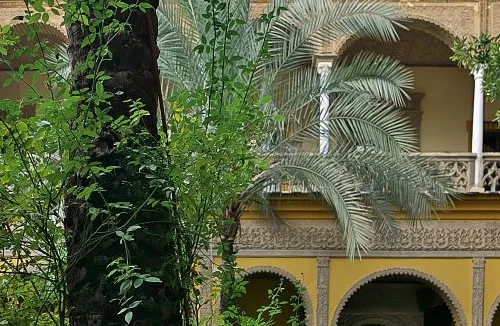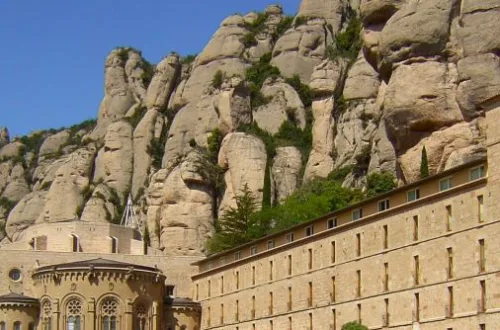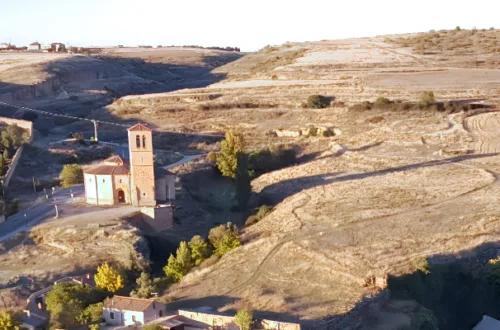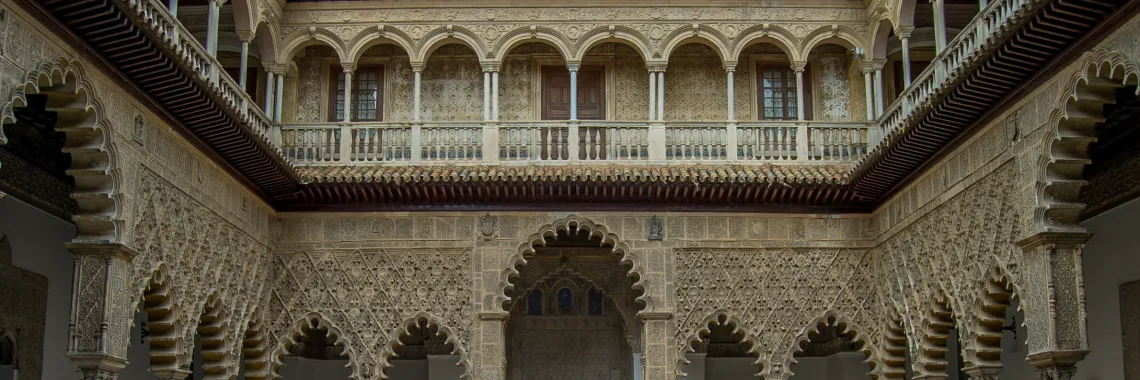
The Allure of Al-Ándalus: Moorish Architecture in Seville
As you wander through the vibrant streets of Seville, the air carries whispers of a storied past. Here, the Moorish architecture is not just a backdrop; it’s the soul of the city. Seville, a canvas painted with the intricate patterns and bold silhouettes of Islamic design, invites you to explore the living legacy of Al-Andalus. This golden age of cultural fusion left an indelible mark on the city’s art, history, and culture. With each step, you uncover the tales of sultans and poets who once walked these very paths.
- Moorish Architecture in Seville's Heartbeat
- The Historical Tapestry of Seville: A Moorish Chronicle
- Defining Moorish Architecture: Seville's Signature Style
- Landmarks of Moorish Architecture in Seville
- The Royal Alcázar : A Testament to Moorish Architecture in Seville
- La Giralda: Seville's Moorish Architecture Masterpiece, Touching the Skies
- Torre del Oro: A Sentinel by the Guadalquivir with Moorish Beginnings
- The Casa de Pilatos: A Fusion of Renaissance Grace and Mudéjar Tradition
- Hospital de los Venerables: Seville's Hidden Courtyard of Moorish Architecture Splendor
- Palacio de la Condesa de Lebrija: Where Roman Mosaics Meet Moorish Design
- Metropol Parasol: A Modern Tribute to Seville's Moorish Architectural Heritage
- The Cultural Impact of Moorish Aesthetics: Seville's Artistic Symphony
- Walking Through History: A Tour of Moorish Architecture in Seville
- 1. Starting Point: The Giralda (the most famous Moorish Architecture in Seville)
- 2. The Royal Alcázar: A Tapestry of Tiles and Gardens
- 3. Casa de Pilatos: A Fusion of Cultures
- 4. Metropol Parasol: A Contemporary Interpretation
- 5. Ending Your Tour: The Flamenco Clubs
- Tips for Visitors interested in Moorish Architecture in Seville:
- Preservation and Legacy: Safeguarding Moorish Architecture in Seville
- The Timeless Charm of Moorish Architecture in Seville
Moorish Architecture in Seville’s Heartbeat
In every corner of Seville, the heartbeat of Moorish architecture pulses strong. The city’s skyline tells a story of a time when the Moors turned Andalusia into a center of enlightenment. Today, Seville beckons travelers with its harmonious blend of past and present. It’s a place where ancient palaces stand shoulder to shoulder with lively tapas bars. And it’s in this dance between the old and the new that you find the true essence of Seville.
Transitioning seamlessly from one era to another, Seville holds its history close. The grandeur of Moorish architecture in Seville is not just in the grand palaces and mosques converted to cathedrals but also in the details. It’s in the quiet courtyards, the rippling fountains, and the sun-kissed orange groves that the spirit of Al-Andalus still thrives. As you meander through this architectural wonderland, each element tells a part of Seville’s rich Moorish tale.
Embrace this journey through time and let Seville’s Moorish architecture captivate your senses. With every archway and carved doorway, you’re not just seeing a city; you’re experiencing a vibrant chapter of Spain’s cultural tapestry. So come, let the allure of Al-Andalus enchant you as it has done for centuries.
The Historical Tapestry of Seville: A Moorish Chronicle
The story of Moorish architecture in Seville begins with a voyage. In the 8th century, the Moors crossed into Spain, bringing with them a culture rich in arts and sciences. They reached a zenith in Al-Ándalus, an era of unparalleled cultural prosperity. Seville, under Moorish rule, blossomed into a city of knowledge and grandeur. The Moors left an indelible mark here, transforming the city with their distinctive architectural style.
Seville became a showcase of Moorish craftsmanship. The city’s transformation was profound, with architects weaving Islamic artistry into the very fabric of Seville. They etched their legacy into stone and tile, leaving behind a treasure trove of history. It’s a legacy that stands proud, even as centuries have passed. Today, the Moorish architecture of Seville offers a window into a past where different cultures thrived together.
This history is alive in the city’s bones. It breathes through the walls of the Alcázar and echoes in the halls of ancient homes. Seville’s role in the Moorish empire was not just as a political stronghold but as a heart of architectural innovation. Here, the fusion of function and art reached new heights, creating spaces that were both splendid and serene.
As you explore Seville, the influence of Moorish architecture is unmistakable. From the whispering fountains to the cool, tiled alcoves, every detail tells a story. These stories are the threads in Seville’s historical tapestry, a rich mosaic that continues to captivate and inspire. So let us pull back the curtain on this chapter of Seville’s past and discover how the Moors shaped a city that enchants to this day.
Defining Moorish Architecture: Seville’s Signature Style
Moorish architecture in Seville is a visual symphony, a blend of form, function, and fantasy. At its heart lie the horseshoe arches, curving gracefully as if in perpetual bloom. These arches frame doorways and windows, inviting you into a world where every surface tells a story. Intricate tile work, or azulejos, cloak the interiors with vibrant patterns. They create a kaleidoscope of color that dazzles the eye. Water features, from grand fountains to tranquil reflecting pools, add a layer of serenity. They mirror the clear Andalusian skies and the artistry that surrounds them.
But the true essence of Moorish architecture in Seville lies in its fusion. Islamic artistry meets local Spanish techniques here. It’s a dance of cultures, each step a brushstroke of shared heritage. Artisans from different backgrounds came together, their collaboration giving rise to a style unique to Seville. This architectural dialogue has survived the test of time. It continues to influence design to this very day.
As you wander through Seville, let the city’s Moorish architecture guide your way. Notice how each arch, tile, and waterway leads you to the next discovery. The fusion on display is not just of materials and motifs but of histories and hearts. It’s a living testament to Seville’s multicultural past. And it’s this enduring legacy that beckons lovers of art and history from around the world. So step closer. Look. Listen. The stones of Seville have endless stories to share.
Landmarks of Moorish Architecture in Seville
Seville’s skyline tells a story of Moorish magnificence. Each landmark stands as a testament to the city’s Moorish architectural heritage. The Giralda tower, once a minaret, now soars as a bell tower. It beckons visitors with its storied ascent and breathtaking views. Nearby, the Real Alcázar palace complex unfolds like a history book in stone and tile. Its halls and gardens whisper tales of sultans and queens.
These landmarks are the soul of Moorish architecture in Seville. They capture a time when art and power walked hand in hand. The Alcázar’s walls, adorned with geometric patterns, reflect a universe of mathematical precision and spiritual contemplation. Courtyards play with light and shadow, creating spaces that feel both open and intimate. Water runs through it all, a symbol of life and luxury in the arid lands of Andalusia.
The Royal Alcázar : A Testament to Moorish Architecture in Seville
In the heart of Seville, the Royal Alcázar stands as a pinnacle of Moorish architecture. This palatial fortress began its journey in the 10th century. It was a time when the Umayyad caliphs dreamt of creating an earthly reflection of paradise. Over the centuries, the Alcázar evolved. Each ruler left their mark, expanding and enriching this architectural masterpiece.
The Alcázar’s walls have witnessed history unfold. They have seen Seville grow from a Moorish stronghold into a diverse, vibrant metropolis. The palace itself is a narrative of transformation. It showcases a seamless blend of Islamic, Mudéjar, and Gothic styles. This fusion is what gives the Alcázar its unique character and cultural significance.
As you step into its courtyards, you step back in time. The Patio de las Doncellas captures the essence of Moorish design with its reflective pool. The symmetry here is not just visual; it’s poetic. Columns and arches frame spaces that invite contemplation and awe. The intricate tile work tells stories—of love, power, and faith.
The evolution of the Alcázar did not stop with the Reconquista. When Christian monarchs took Seville, they too fell under the spell of its Moorish charm. They added elements like the grand Gothic palace but kept the Islamic artistry intact. This respect for the past is what makes the Alcázar a cultural jewel.
Today, the Royal Alcázar is not just a monument to Moorish architecture in Seville. It is a living part of the city’s soul. It hosts royal events and welcomes visitors from around the world. Each guest leaves with a sense of connection to a story that spans centuries.
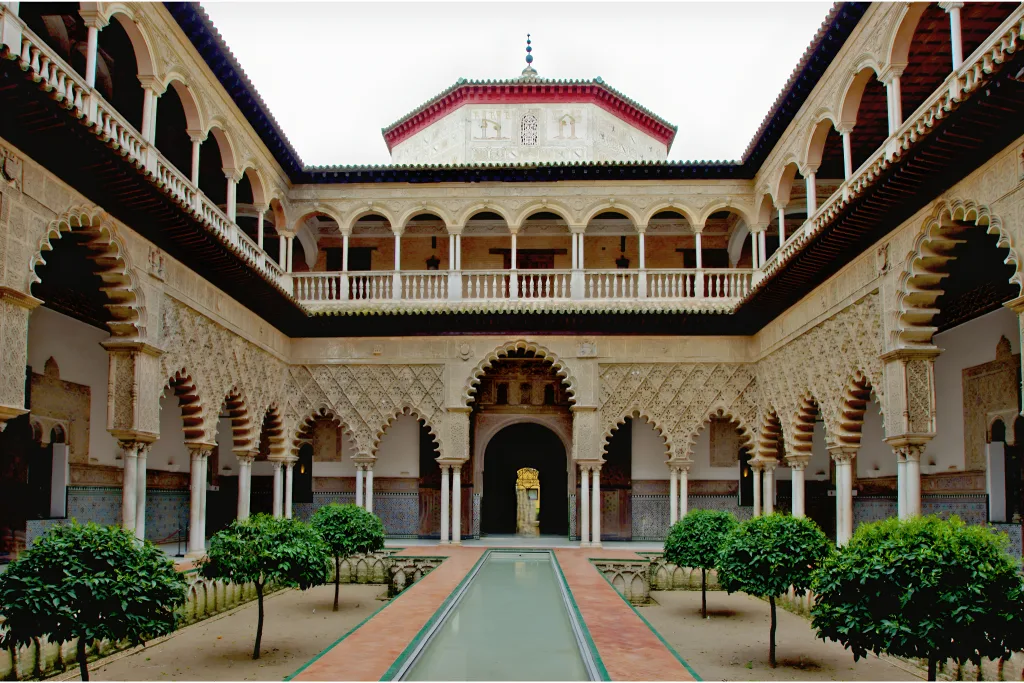
La Giralda: Seville’s Moorish Architecture Masterpiece, Touching the Skies
La Giralda, the emblematic bell tower of Seville, pierces the skyline with its storied height. This architectural marvel began as a minaret. It served the grand mosque of Seville during Moorish rule. Today, it stands as a bell tower, a seamless blend of Islamic and Christian influences. This transformation is a narrative of Seville’s rich, multicultural history.
The tower’s ascent is not just a climb but a journey through time. As you ascend, the echoes of the past follow you. The intricate brickwork and arched windows are hallmarks of Moorish architecture in Seville. They tell of a time when the call to prayer resonated from its heights. The Giralda’s robust foundation has withstood the test of time. It has seen the city evolve from its Islamic roots to a flourishing cultural hub.
Transitioning from minaret to bell tower, La Giralda’s silhouette became an icon. It represents the harmonious coexistence of different cultures. The Christians who later added the belfry did not erase its Moorish soul. Instead, they built upon it, creating a symbol of unity that defines Seville’s spirit.
La Giralda’s story is a testament to the enduring legacy of Moorish architecture in Seville. It stands proudly, a beacon that draws visitors from across the globe. Its presence on the skyline is a constant reminder of Seville’s ability to blend the old with the new. To witness La Giralda is to see centuries unfold before your eyes.
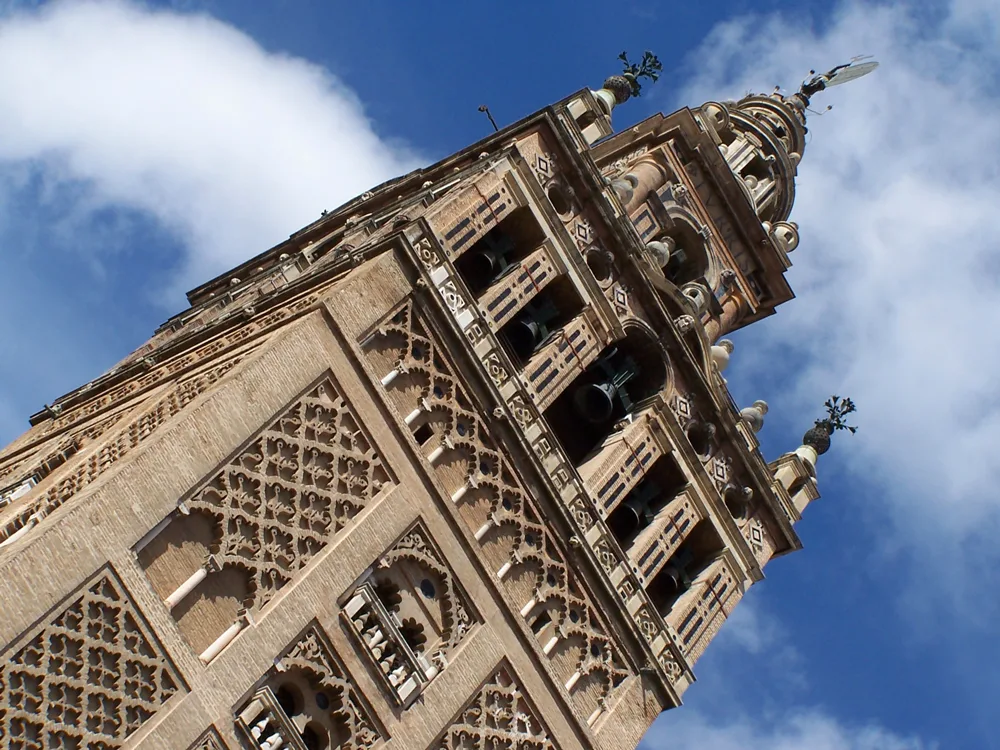
Torre del Oro: A Sentinel by the Guadalquivir with Moorish Beginnings
Perched on the banks of the Guadalquivir River, the Torre del Oro stands as a monument to Seville’s Moorish past. This military watchtower, with its gleaming golden reflection, once formed part of the city’s defensive walls. Built in the 13th century, it showcases the military ingenuity of Moorish architecture in Seville. Its robust walls and strategic location speak to a time when vigilance was as vital as beauty.
The Torre del Oro’s dodecagonal structure is a marvel of design. It has stood the test of time, surviving sieges and centuries alike. The tower’s purpose has shifted through the ages. It has been a prison, a chapel, and now a maritime museum. Yet, its Moorish roots remain evident in its form and detail.
As you approach the tower, the sunlight plays off its surface. It reminds us why it’s called the “Tower of Gold.” Inside, the stories of Seville’s naval history come to life. Each level ascends to reveal panoramic views of the river and city beyond. The tower not only watched history unfold, but also actively shaped it.
Today, the Torre del Oro is a beacon for those seeking to understand Moorish architecture in Seville. It invites exploration and contemplation. Visitors can immerse themselves in its history and enjoy the vistas that once guarded the city’s heart.
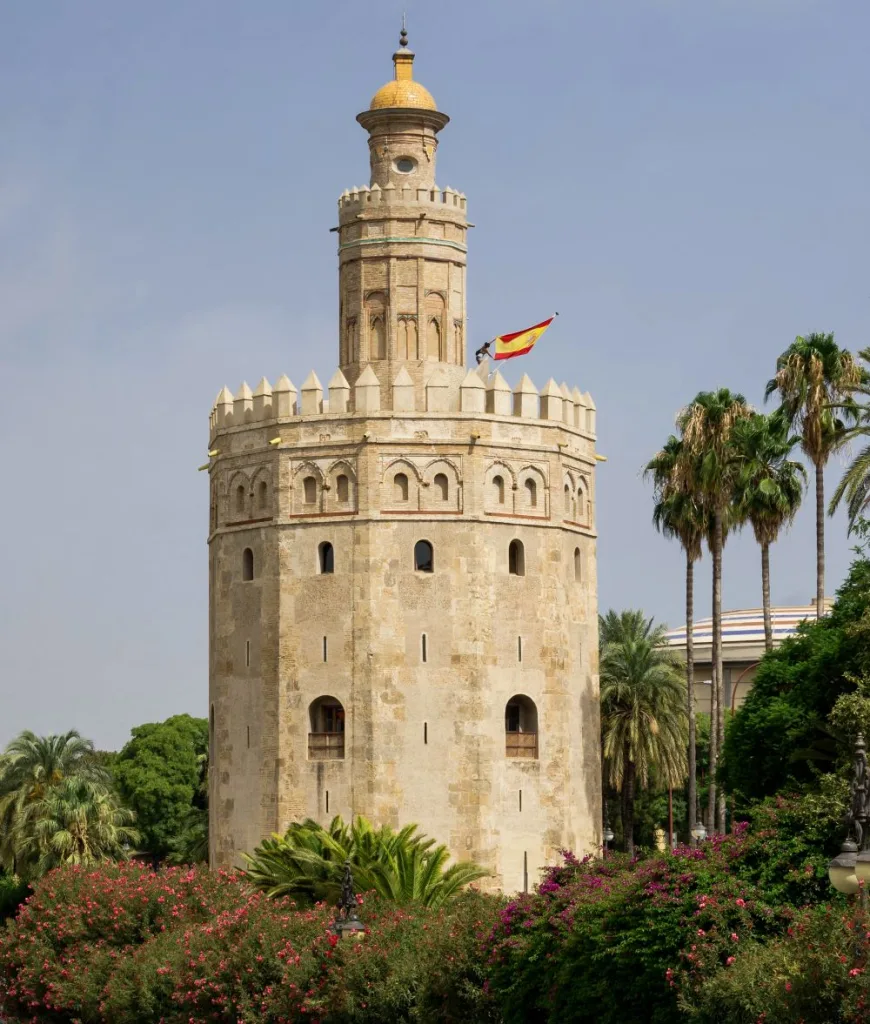
The Casa de Pilatos: A Fusion of Renaissance Grace and Mudéjar Tradition
Nestled in the heart of Seville, the Casa de Pilatos stands as a testament to the city’s architectural heritage. This palatial home is a canvas showcasing the rich tapestry of Moorish architecture in Seville. It marries the elegance of the Renaissance with the intricate Mudéjar style. This blend creates a visual symphony that speaks to both the eyes and the soul.
As you cross the threshold of the Casa de Pilatos, you step into a world where two eras converge. The courtyard, with its vibrant tiles and flowing fountains, whispers stories of the past. Here, the Mudéjar influence shines. It reveals itself in the elaborate stucco work and the delicate lattice woodwork that frames the windows.
The Renaissance’s touch graces the grand staircase and the upper chambers. Yet, it bows to the Moorish legacy that permeates the space. The architects and artisans honored this legacy. They crafted a dwelling that resonates with history’s depth and the allure of cross-cultural exchange.
Visitors are not mere spectators here; they are participants in a dialogue that spans centuries. The Casa de Pilatos offers more than just a glimpse into Seville’s past. It invites you to experience the harmony of styles that defines this Andalusian gem.
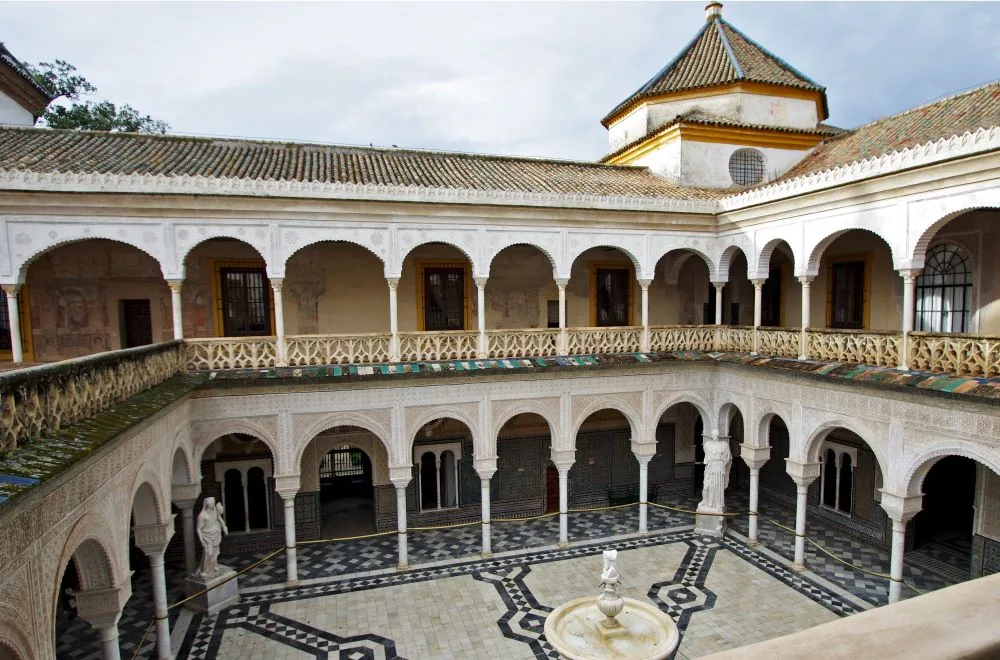
Hospital de los Venerables: Seville’s Hidden Courtyard of Moorish Architecture Splendor
Tucked away in the labyrinthine heart of Seville, the Hospital de los Venerables often escapes the tourist map. Yet, this unassuming gem cradles a patio of such beauty, it rivals the city’s grandest palaces. Here, the intricate Moorish designs whisper tales of a rich cultural tapestry that is quintessential to Moorish architecture in Seville.
As you step into the sun-dappled courtyard, your eyes trace the elegant lines of Moorish artistry. The space is alive with history. Archways and azulejos, the colorful ceramic tiles, speak to a time when Muslim, Jewish, and Christian craftsmen worked side by side. Together, they created a visual ode to intercultural dialogue and artistic collaboration.
The patio serves as the heart of the complex. It beckons visitors with its tranquil fountains and lush greenery. These elements are signatures of Moorish design, reflecting a love for water and nature that is both practical and poetic. The air here carries a coolness, a welcome respite from the Andalusian sun.
Every column and cornice in the Hospital de los Venerables showcases the finesse of Moorish craftsmanship. This attention to detail is a hallmark of Moorish architecture in Seville. It reveals a reverence for design that transcends mere function. The building was once a sanctuary for aging priests. Now, it is a sanctuary for beauty and history.
The Hospital de los Venerables invites you to linger. To gaze upon its patio is to understand the depth of Seville’s architectural heritage. It is a place where the past is not just remembered; it is felt. Come and discover this lesser-known jewel. Experience the serenity that fills its spaces and let the intricate Moorish designs transport you to another era.
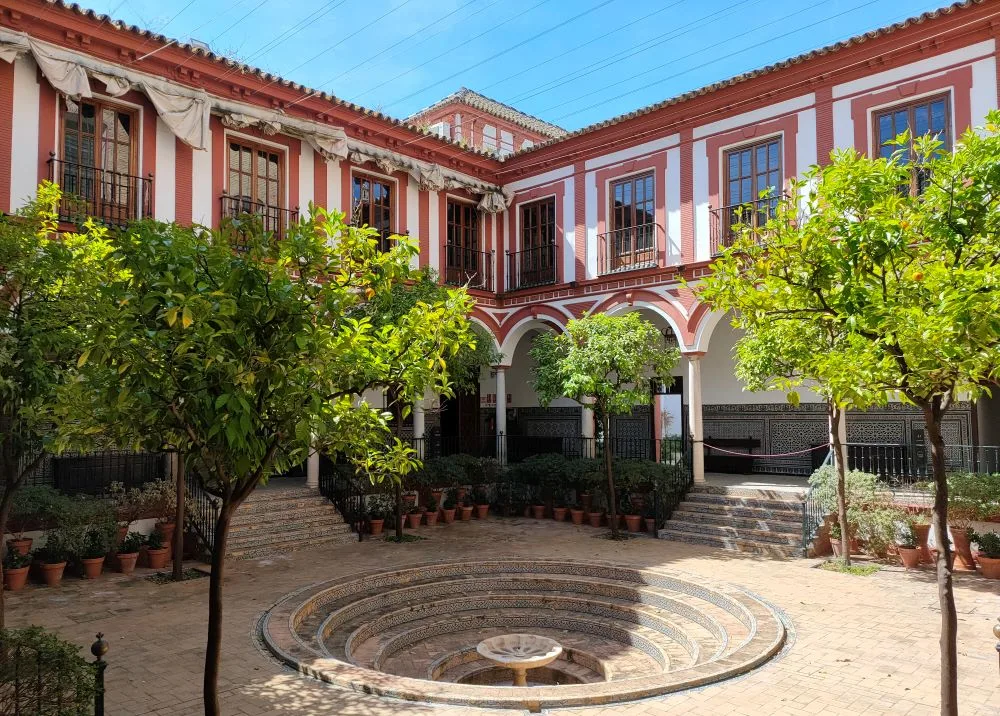
Palacio de la Condesa de Lebrija: Where Roman Mosaics Meet Moorish Design
In the winding streets of Seville, the Palacio de la Condesa de Lebrija stands as a hidden treasure. This palace is a sanctuary of history, where the grandeur of Roman mosaics and Moorish architecture in Seville converge. It’s a place that tells a story of cultural layers, woven together through time.
The moment you enter, the palace captivates you. The collection of Roman mosaics, one of the finest in the world, spreads beneath your feet. These ancient artworks offer a glimpse into a bygone era. They lie in harmony with the Moorish designs that adorn the walls and ceilings around them.
Every room in the Palacio de la Condesa de Lebrija is a chapter from history. The mosaics tell tales of Roman life and mythology. Surrounding them, the Moorish architecture speaks of the Islamic influence that shaped Seville. The palace is not just a home to artifacts; it’s a canvas displaying the fusion of cultures.
As you move from room to room, the narrative unfolds. The palace’s courtyards, with their intricate tile work and ornate arches, are a testament to the skill of Moorish craftsmen. These spaces offer respite and reflection. They invite you to ponder the past and its enduring beauty.
The Palacio de la Condesa de Lebrija is more than a museum. It’s a living example of how Moorish architecture in Seville has been preserved and celebrated. It stands proudly, sharing its legacy with all who walk its storied halls.
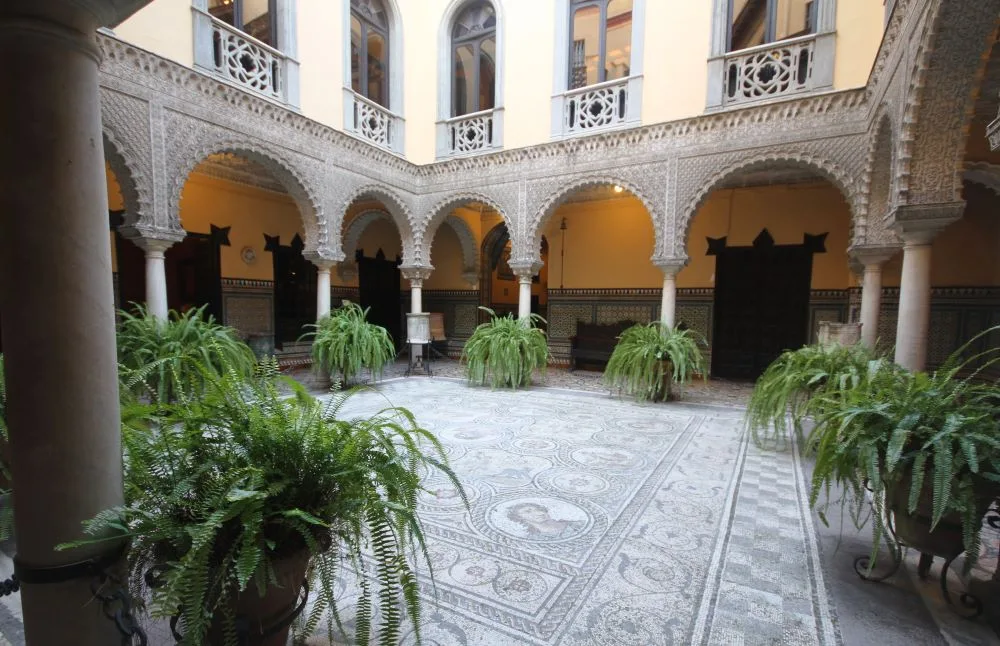
Metropol Parasol: A Modern Tribute to Seville’s Moorish Architectural Heritage
In the vibrant cityscape of Seville, the Metropol Parasol emerges as a bold reinterpretation of Moorish design. This contemporary landmark, a wooden structure of vast proportions, weaves the ancient with the avant-garde. It reimagines the essence of Moorish architecture in Seville for the 21st century.
As you approach the Metropol Parasol, its undulating forms capture your imagination. The design echoes the interlacing arches and geometric patterns that are the soul of traditional Moorish architecture. Here, they are reborn in sweeping curves and honeycomb vaults that stretch towards the sky.
This modern marvel does more than dominate the skyline. It invites interaction and exploration. Its platforms offer sweeping views of the city, a nod to the watchtowers and high walls that once defined Seville’s horizon. The structure is not just seen; it is experienced.
Beneath its shade, the Metropol Parasol holds space for public life. Markets and cafés buzz with activity, reminiscent of the bustling souks that thrived in Moorish times. The connection is palpable. The spirit of communal gathering, so central to Moorish culture, lives on in this contemporary hub.
Seville’s commitment to preserving and reinterpreting its Moorish roots shines through the Metropol Parasol. It stands as a dialogue between the past and present, proving that Moorish architecture in Seville is not just a historical footnote. It is a living, evolving legacy.
The Metropol Parasol challenges you to see Moorish design through a new lens. It is a testament to Seville’s enduring love affair with architectural innovation. Witness this structure and let it inspire you. In its shadows and light, the story of Seville continues to unfold.
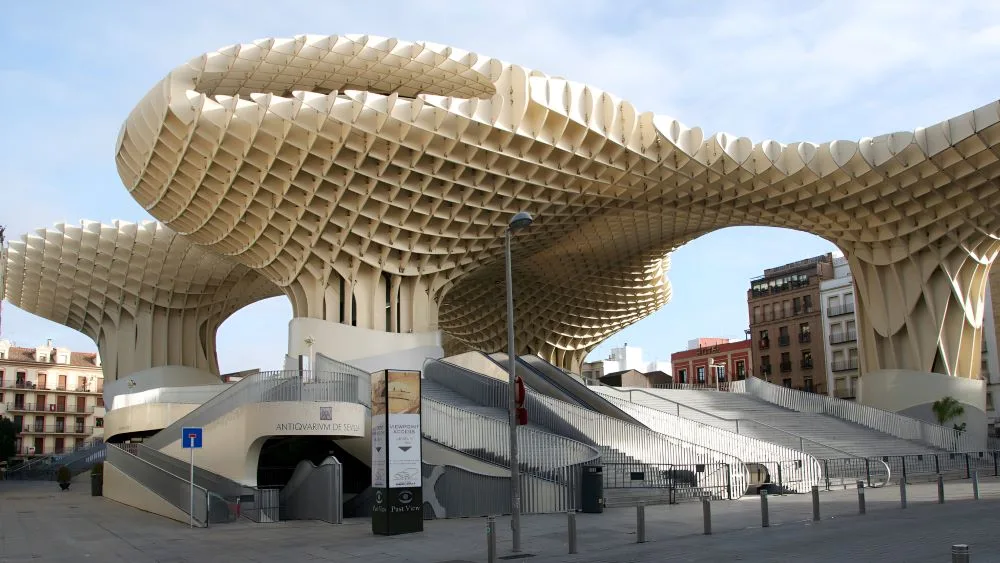
The Cultural Impact of Moorish Aesthetics: Seville’s Artistic Symphony
Seville’s heartbeat is rhythmic with cultural influences, and the echo of Moorish aesthetics is particularly resonant. The city’s narrative is a mosaic where each tile reflects a broader story. This story is vividly told through the distinctive elements of Moorish architecture in Seville. It’s a tale of convergence and creativity.
As you wander through Seville’s streets, the impact of Moorish design is undeniable. The azulejos, those vibrant ceramic tiles that adorn many a wall and fountain, are a canvas of history. They capture the Moorish penchant for geometry and color. These tiles are not mere decorations; they are cultural ambassadors. They tell of a time when art was a bridge between diverse communities.
Flamenco music, with its passionate rhythms and soulful melodies, also carries a Moorish legacy. The strumming of the guitar and the percussive footwork echo in courtyards designed by Moorish hands. These performances are more than entertainment. They are a living expression of Seville’s Moorish past.
The influence of Moorish architecture in Seville extends beyond the visual. It infuses the city’s very essence. Craftsmen and artists continue to draw inspiration from its motifs and methods. The result is a cultural tapestry that is both rich and enduring.
Seville’s identity is inseparable from its Moorish roots. This heritage shapes the city’s present and future. It is celebrated in every azulejo-clad patio, in every note of flamenco music. The cultural impact of Moorish aesthetics is a story that Seville tells with pride and artistry.
Walking Through History: A Tour of Moorish Architecture in Seville
Embark on a journey through the winding streets of Seville, where every corner whispers stories of the past. This walking tour is a curated path connecting the major sites showcasing Moorish architecture in Seville. Let’s delve into a world where history is etched in stone and tradition breathes through the very walls.
1. Starting Point: The Giralda (the most famous Moorish Architecture in Seville)
Begin your exploration at the Giralda, the towering minaret turned bell tower. This masterwork sets the stage for your adventure. It soars skyward, a silent testament to Seville’s Moorish past. Capture its grandeur in the morning light; this is when photographs truly do it justice.
2. The Royal Alcázar: A Tapestry of Tiles and Gardens
A short stroll leads you to the Royal Alcázar. Here, gardens and palaces unite in a sublime expression of Moorish design. Wander through its courtyards, where sunlight dances on intricate azulejos. Take your time; these are moments to savor. For photographers, the play of light and shadow here creates images straight out of a dream.
3. Casa de Pilatos: A Fusion of Cultures
Next, let the Casa de Pilatos beckon you with its blend of Renaissance and Moorish styles. This palace is quieter, offering a more introspective experience. Notice how the architecture tells a story of cultural fusion. In the soft afternoon light, each detail stands out, begging to be captured through your lens.
4. Metropol Parasol: A Contemporary Interpretation
As the day wanes, make your way to the Metropol Parasol. This modern structure pays homage to Seville’s Moorish heritage through its design. Stand beneath its expansive canopy as the sun sets. The interplay of light creates a mesmerizing effect, perfect for those seeking a unique photographic perspective.
5. Ending Your Tour: The Flamenco Clubs
Conclude your tour in the heart of Seville’s flamenco district. Here, the spirit of Moorish architecture in Seville lives on in music and dance. As night falls, the vibrant rhythms offer a fitting soundtrack to reflect on your day’s journey.
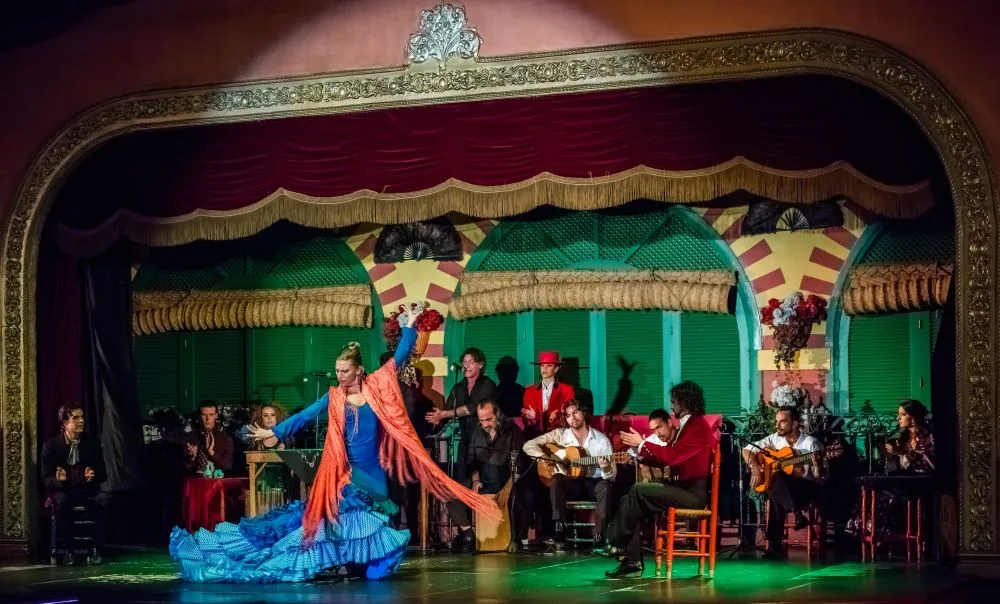
Tips for Visitors interested in Moorish Architecture in Seville:
- Begin early to avoid crowds and capture the best light.
- Wear comfortable shoes; cobbled paths are part of the charm, but can be unforgiving.
- Pause often, look up, and around. The details in Moorish architecture are not just found at eye level.
- Respect the sites; these are places of cultural significance.
- Lastly, let the city’s history guide you. Each site has a tale to tell, and the best way to experience them is by listening.
This walking tour is more than a checklist of sites. It’s an immersive experience into the heart of Moorish architecture in Seville. With each step, you walk through history, and with every photo, you capture a piece of Seville’s soul.
Preservation and Legacy: Safeguarding Moorish Architecture in Seville
Seville’s skyline tells a story of cultural crossroads, where the most eloquent narrators are its Moorish architectural marvels. The city’s dedication to preserving these historical treasures speaks volumes about their significance to Spanish heritage. Each archway, courtyard, and tile reflects a commitment to the past and a promise for the future.
The Pillars of Preservation of Moorish Architecture in Seville
Efforts to preserve the distinctive Moorish architecture in Seville are foundational to maintaining Spain’s diverse cultural identity. These efforts ensure that every generation can touch, see, and experience the historical grandeur. Preservationists work tirelessly, applying both traditional techniques and modern science to keep these structures standing proud.
UNESCO World Heritage Sites: A Seal of Protection
International recognition plays a crucial role in the conservation of Seville’s Moorish wonders. When UNESCO bestows the title of World Heritage Site, it is not just an honor. It is a global commitment to protect and cherish these landmarks. The Alcázar, the Cathedral, and the Archivo de Indias in Seville have all received this prestigious designation.
This recognition brings attention and resources. It also fosters a sense of global stewardship. These sites are not just Spanish treasures; they are the world’s. They hold stories that are universal — tales of art, power, faith, and innovation.
The preservation of Moorish architecture in Seville is more than maintaining buildings. It is about upholding a legacy that has shaped not just a city or a nation, but the entire tapestry of human culture. As caretakers of this legacy, we are all part of a narrative that transcends borders and epochs.
Tips for Visitors:
- Engage with local preservation efforts by visiting sites responsibly.
- Support the maintenance of these sites through patronage and education.
- Capture photographs that respect the integrity and sanctity of these historical spaces.
In Seville, every stone tells a story, every corridor echoes with history. As we walk through these spaces, we walk through time — a journey made possible by the enduring efforts to preserve the legacy of Moorish architecture in Seville.
The Timeless Charm of Moorish Architecture in Seville
As our journey through the streets of Seville comes to a close, the enduring allure of Moorish architecture remains vivid in our minds. These structures are more than mere remnants of the past; they are the vibrant heart of the city’s identity. With their intricate designs and enduring beauty, they invite us to step into a living history that continues to pulse through the veins of Seville.
Seville’s Soul: A Legacy Carved in Stone
The legacy of Moorish architecture in Seville is etched into every arch, column, and courtyard. It’s a narrative set in stone, telling tales of a time when Al-Andalus flourished. These monuments stand as proud sentinels, guardians of history, shaping Seville’s character and its skyline. They are not just attractions; they are the essence of the city’s soul.
An Invitation to Walk Through Living History
Experience this living history. Walk the path of kings and caliphs. Feel the texture of ancient stones beneath your fingertips. Hear the whisper of centuries-old secrets as you meander through shadowed halls. The Moorish architecture of Seville does not merely exist within the city—it is an integral part of its vibrant tapestry.
Discovering Al-Andalus Today
In every visit, in every gaze that lingers on the delicate patterns of tilework, you become a part of Seville’s unfolding story. The city beckons you to discover its Moorish roots—a journey that promises to be as enchanting as the tales woven by its ancestors. It’s a living museum where every visitor becomes a witness to the splendor that was, and is, Al-Andalus.
A Final Thought about Moorish Architecture in Seville
So we leave you with this thought: Moorish architecture in Seville is not just a chapter in history books. It is a chapter that is still being written, with every sunrise that graces its spires and every sunset that bathes its walls in golden hues. Come and write your own page in Seville’s story—a city where the past is always present and the beauty of Moorish architecture awaits your discovery.


